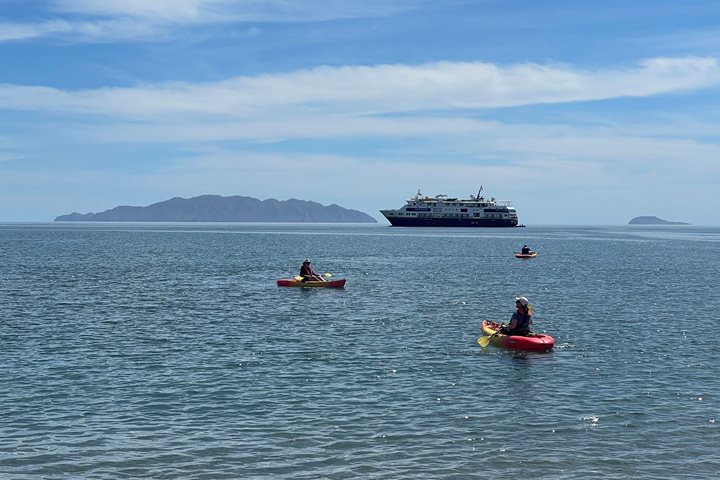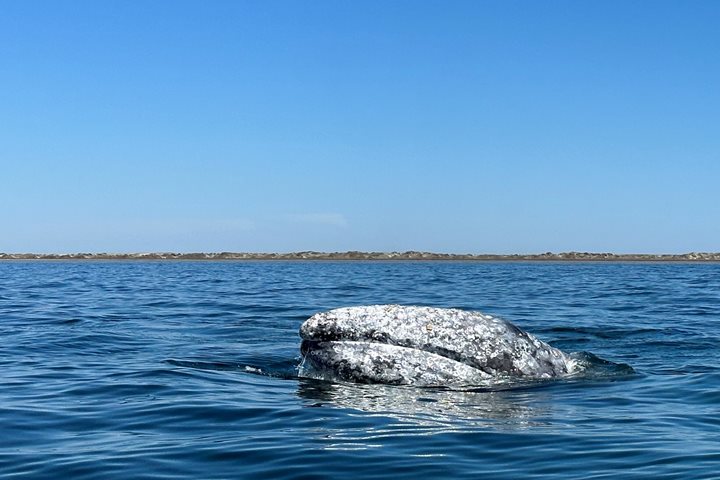For this morning, we arranged an early sunrise party to San Esteban Island, which lies in the Midriff area of the Gulf of California. Facing southeast, the wide Arroyo Limantour is the best location to contemplate the sun rising over the mainland of Mexico. After breakfast, our guest and naturalists walked on the arroyo in search of the “pinto” or piebald chuckwalla, an endemic, “gigantic” version of the normal, mainland form of this lizard, and the spiny-tailed iguana, which constitute another endemic species. These iguanas climb up to the tops of cardon cacti to get the nutritious flowers and fruits. San Esteban has long been a very isolated island, and many of its reptiles and cacti are unique. Therefore it is regarded a “laboratory of evolution” by biologists. The waters around, though cold and with complicated currents, shelter a great diversity of marine wildlife too, so our expedition diver Maya ventured in the sea and captured this biodiversity with a submersible video camera. At noon, the National Geographic Sea Bird sailed north for the afternoon activities, and we encountered bottle-nosed and long-beaked common dolphins in the way. We anchored at Rasa, a little island that is the colonial breeding site for elegant and royal terns and Heermann’s gulls, and made cruises around it on the expedition landing craft. During these, guests and staff were enchanted with the number of nesting seabirds and their vocalizations (that filled the air and our ears with metal-like and laughing-like sounds). Dr. Enriqueta Velarde (a leading researcher and ornithologist of Rasa) joined us for dinner and made a presentation of her work on the island. We learnt a lot today and had a lot of fun!
- Daily Expedition Reports
- 10 Apr 2018
San Esteban Island & Rasa Island, 4/10/2018, National Geographic Sea Bird
- Aboard the National Geographic Sea Bird
- Baja California
Adrian Cerda, Naturalist
Adrian studied biology at the national Autonomous University of Mexico. In 1991 the Wildlife Preservation Trust of Jersey, on Britain's Channel Islands, awarded Adrian with a scholarship to its prestigious 16-week training program in Captive Manageme...
Read MoreShare Report
Baja California: Among the Great Whales
VIEW ITINERARYRelated Reports
3/21/2025
Read
National Geographic Venture
Canal de Cerralvo / La Paz
We awoke navigating on the Cerralvo Canal, between Cerralvo Island and the peninsula, searching for wildlife. We were not disappointed, as two different pods of common dolphins came to visit and bow ride with us for a long time. After lunch, we anchored at Pichilingue Port and disembarked the vessel to visit the capital city of Baja California Sur, La Paz, where we had the chance to interact with the locals in some of the most popular places, like La Fuente, a traditional ice cream parlor, and the Jardin Velasco in downtown. Then guests enjoyed a fiesta, dinner, and returned on board National Geographic Venture .
3/20/2025
Read
National Geographic Venture
Magdalena Bay
Today we woke with the shining stars and took Zodiacs ashore to meet our coaches for a trip to Chale, a small town on the shores of Magdalena Bay. The goal was to find some wintering gray whales, magnificent leviathans which frequent this coast to give birth before the long migration back to their Arctic feeding grounds. These whales did not disappoint! Spyhopping, breaching, and even a bit of tail flukes. As a result, there were lots of smiles and laughter all around! We returned to the town for lunch and then headed back out on the local boats for a second round. As we returned to the ship, the sun set over La Paz, with glassy waters of gold in the harbor, and pink clouds above. The constellations of Orion, Taurus, and the Pleiades shone over our Zodiacs on our way back to dinner aboard National Geographic Venture .







